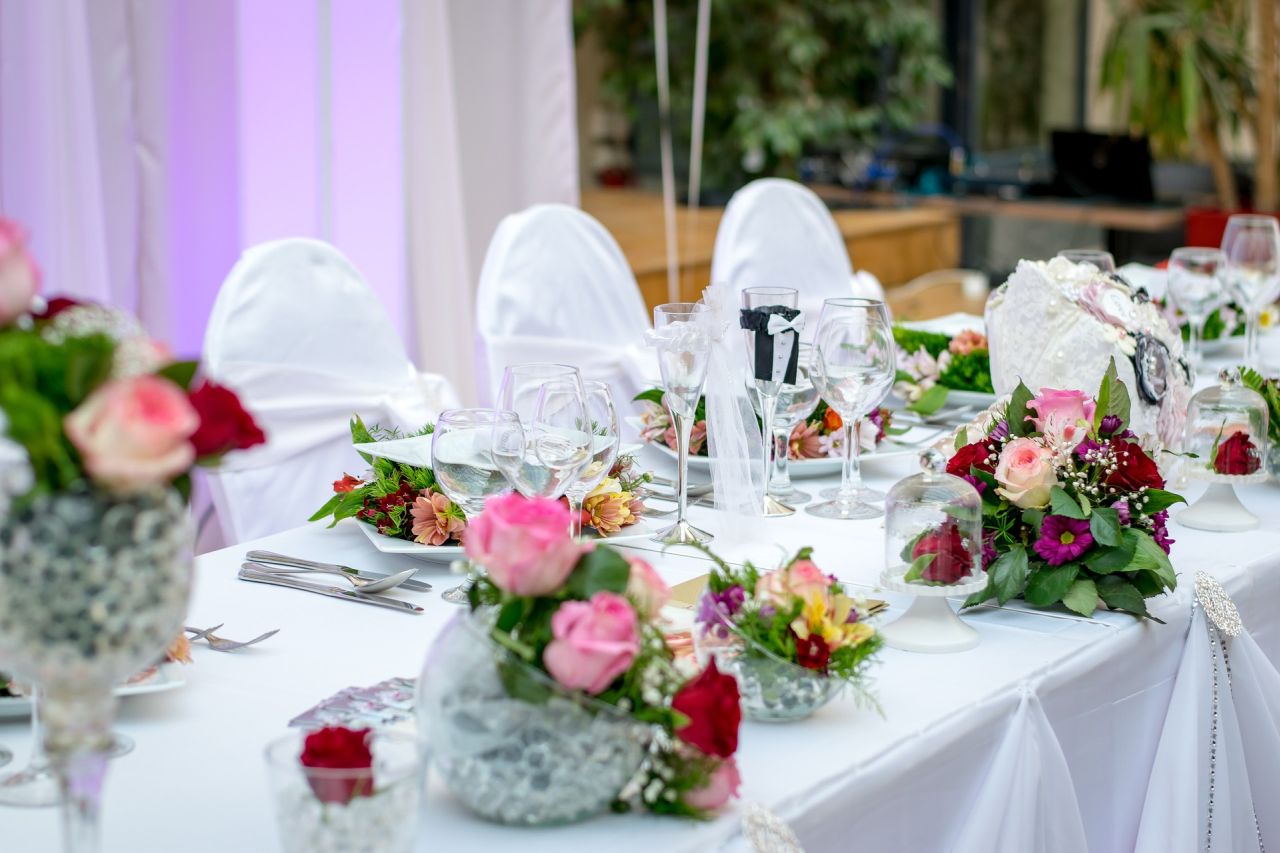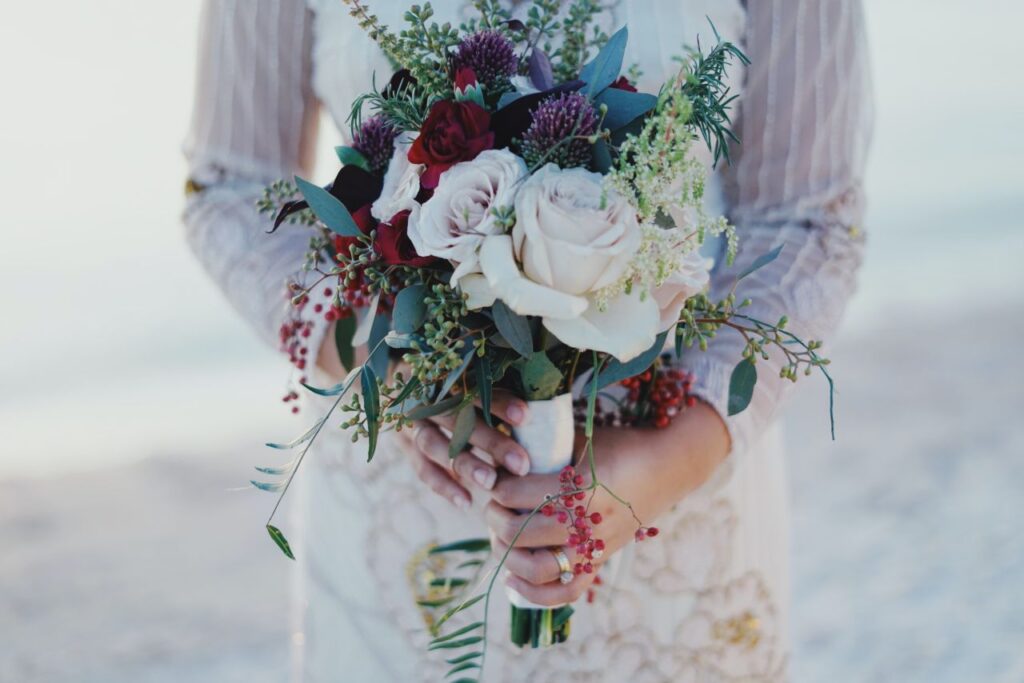Choosing a wedding florist is essential in creating a memorable, beautiful wedding day. The right flowers can set your event's tone, ambience, and overall feel, making it uniquely yours.
This guide covers everything you need to know, from when to start looking to questions to ask when selecting your ideal wedding florist.
Let’s get straight to the point
Choosing the right wedding florist involves thoughtful steps to ensure your floral arrangements enhance your wedding's ambience and style. Start your search 6-8 months before the wedding, allowing time for consultations and adjustments.
Budget, flower type, style compatibility, experience, and availability are key factors to consider. Researching florists, defining your floral vision, and checking portfolios help match a florist to your wedding’s theme.
Essential arrangements include the bride’s bouquet, centrepieces, and boutonnieres, with greenery or other decorative alternatives as budget-friendly options. During consultations, ask detailed questions about pricing, setup, and service logistics.
Finalise your decision by carefully reviewing contracts, confirming logistics, and choosing a trusted florist. A thoughtful selection of flowers and a skilled florist can make your wedding day visually stunning and memorable.
When to Start Looking for a Wedding Florist?

Timing is crucial. Ideally, you should start looking for a wedding florist at least six to eight months in advance. This timeframe allows ample room for consultations, budget adjustments, and unexpected changes. Booking early is particularly beneficial if your wedding date falls within peak wedding season, as popular florists are often reserved months ahead.
Key Factors to Consider When Choosing a Wedding Florist
When narrowing down your options, keep the following in mind:
1. Budget
Before reaching out to florists, establish a firm budget. Floral arrangements represent up to 10% of your wedding budget, so knowing your limits helps you find florists within your price range. Once you know what you can spend, communicate this openly with each florist to ensure transparency from the beginning.
2. Types of Flowers
Each florist has their preferred selection of flowers based on seasonality, availability, and style. Discuss your vision with them, especially if you have specific flowers in mind. Keep in mind that flowers out of season may significantly increase costs.
3. Style and Aesthetic Compatibility
Different florists specialise in various styles—from minimalistic and modern to lush and romantic. Ask to see portfolios to understand their unique design approach and confirm whether it aligns with your vision. Choosing a florist whose style resonates with your wedding theme will help bring your ideas to life smoothly.
4. Skill and Experience
A floral arrangement is a form of artistry, and skilled florists demonstrate a natural flair for design. Check references, read reviews, and ask for testimonials from previous clients. Visiting their showroom or requesting photos from recent weddings can provide insight into their work quality.
5. Availability and Flexibility
Availability is essential. Many florists juggle multiple weddings and events, especially during peak seasons. Ensure they can dedicate sufficient time and resources to your wedding. Flexibility is also crucial, as unexpected changes can arise. Choose a florist who is accommodating and open to adjustments to make the experience stress-free.
Tips for Selecting the Right Wedding Florist
Choosing a wedding florist is more than finding someone who can create beautiful arrangements. It's about selecting a professional who understands and delivers on your vision.
1. Conduct Research
Before meeting potential florists, explore different floral styles, trends, and seasonal options. Websites like Pinterest and Instagram are excellent for inspiration. However, remember that replicating exact arrangements may vary based on season and florist availability.
2. Establish a Floral Vision
Decide on a general aesthetic, whether it's a specific colour palette, theme, or flower type. Create a mood board with your favourite designs and styles. By sharing your vision, florists will better understand your preferences and help tailor their ideas to fit your needs.
3. Check for Professionalism and Experience
Meet with potential florists to assess their work experience and professionalism. Request a portfolio of past weddings, which can give insight into their style and quality. Inquire about their experience handling large events if you plan a sizable wedding.
4. Compare Portfolios and Pricing
Compare the styles and pricing structures of different florists. Look for consistency in quality and attention to detail across their work. Experienced florists may charge more, but the quality is often worth the investment. However, newer florists might offer competitive rates and fresh ideas.
Creating a List of Essential Wedding Floral Arrangements

Determine which floral arrangements are most important for your wedding day. Some standard pieces include:
- Bride’s Bouquet: A centrepiece of floral arrangements often reflecting the wedding theme.
- Bridesmaids’ Bouquets: These should coordinate with the bride's bouquet but can be smaller and simpler.
- Boutonnieres: Typically worn by the groom, groomsmen, and close family members.
- Centrepieces: These add elegance to reception tables, ranging from minimalistic vases to extravagant floral installations.
- Cake Flowers: Floral decorations on the cake can tie into the overall theme and add a touch of natural beauty.
If you’re working within a tight budget, consider alternatives like greenery or candle-lit lanterns. Some florists also offer creative alternatives, such as macramé or ribbon arrangements, to add personality to your décor.
Steps for a Smooth Florist Selection Process
1. Meet and Greet: Initial Consultations
Meet each florist in person to review their ideas and share your vision. Bring pictures of arrangements that inspire you, colour palettes, or any other visual cues. This step helps determine if the florist can deliver on your preferences.
2. Review Their Portfolio and Past Work
Carefully review their portfolio to see if they’ve executed similar designs in past weddings. Look for consistency, variety, and creativity in their work. If you have specific ideas, ask if they can replicate or customise similar arrangements.
3. Ask Detailed Questions
Prepare questions about each florist’s process, from initial consultation to setup and breakdown. Key questions to ask include:
- What flowers are in season during my wedding month?
- How long does each arrangement take to set up?
- Do you handle delivery and setup at the venue?
- Can I see samples of my specific requested arrangements?
4. Discuss the Pricing Structure
Understanding a florist’s pricing is critical. Ask for a detailed breakdown of costs, including delivery, setup, and any additional fees for materials like vases or ribbons. Many florists also charge extra for intricate details or custom designs, so clarify each cost element.
Narrowing Down Your Choices
Once you’ve met with several florists, it’s time to narrow down your options based on quality, experience, and pricing. Choose the top two or three candidates and arrange follow-up meetings if necessary. Comparing their offers can help you decide the best fit for your wedding.
Finalising Your Wedding Florist Decision
1. Review the Contract Carefully
The contract should specify all details of the floral arrangements, including types of flowers, sizes, quantities, and additional services. Review all terms carefully, including cancellation policies, delivery schedules, and payment terms. Ensure a clear contingency plan for any flowers that may become unavailable.
2. Confirm Logistics and Timeline
Discuss all logistical aspects with your chosen florist, including setup and breakdown times, delivery schedules, and contact information for the wedding day. Organise a backup plan if any last-minute changes arise, ensuring peace of mind on your big day.
3. Make a Final Decision Based on Confidence and Trust
Beyond pricing and style, choose a florist with whom you feel comfortable and confident. A skilled florist will not only provide beautiful arrangements but will also be a reassuring presence throughout your wedding planning.
Alternatives to Traditional Wedding Flowers
If you’re open to alternatives, consider incorporating non-floral elements. Unique options include:
- Greenery-only arrangements: Adds a fresh, natural look.
- Lanterns and Candles: Creates ambiance without flowers.
- Paper Flowers or Silk Blooms: Perfect for budget-conscious couples or those with allergies.
Conclusion
Flowers can transform a wedding, adding elegance, romance, and warmth to your celebration. Selecting a wedding florist requires attention to budget, style, and logistics. Planning early, researching thoroughly, and choosing someone who understands your vision will ensure your wedding flowers are an unforgettable part of your day.
Consider the elements outlined here and take time to explore each step thoughtfully. The right florist will make your dream wedding come alive with stunning floral arrangements, creating memories that last a lifetime.
FAQs About Weddings
Red wedding flowers - a white wedding dress and a classic red bouquet says all the right things – romance, passion and sensuality. White wedding flowers - a classic choice for your big day. White symbolizes purity and innocence. White flowers go great with all dress colors.
Garden roses, peonies, dahlias and ranunculus are some of the most popular blooms for hand-tied bouquets, along with greenery like eucalyptus, bay leaves and olive branches. Most arrangements are tied with twine or long ribbons that are left to hang loose.
However, we do not recommend flowers being picked up until the day of the wedding. When wedding flowers are stored, they are kept in coolers to stay fresh and happy. Wedding flowers are meant for one day, your wedding day. Their purpose is not to last, their purpose is to look stunning for your day!
Does the wedding bouquet style have to match the wedding centerpieces? No way! Besides walking in with it and possibly tossing it, your bouquet won't appear much at your reception. Even if it does, mixing styles can look gorgeous.
The groom's family provides the flowers involved in a wedding ceremony. That includes the bride's bouquet, the groomsmen and usher boutonnieres, and the corsages and mini bouquets for the both mothers and grandmothers.

